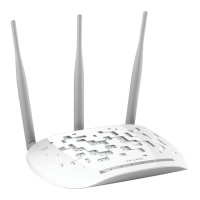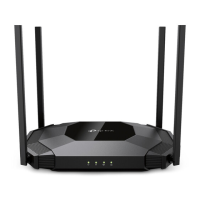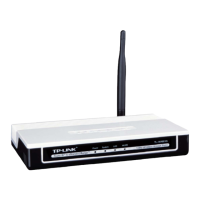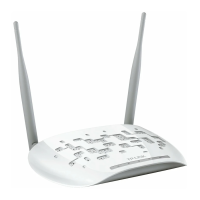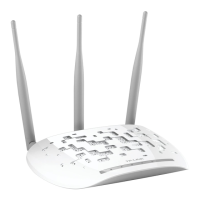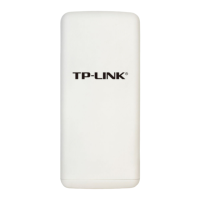TL-WA701ND 150Mbps Wireless N Access Point User Guide
Appendix E: Glossary
802.11b - The 802.11b standard specifies a wireless networking at 11 Mbps using
direct-sequence spread-spectrum (DSSS) technology and operating in the unlicensed radio
spectrum at 2.4GHz, and WEP encryption for security. 802.11b networks are also referred to as
Wi-Fi networks.
802.11g - specification for wireless networking at 54 Mbps using direct-sequence
spread-spectrum (DSSS) technology, using OFDM modulation and operating in the unlicensed
radio spectrum at 2.4GHz, and backward compatibility with IEEE 802.11b devices, and WEP
encryption for security.
Access Point (AP) - A wireless LAN transceiver or "base station" that can connect a wired LAN to
one or many wireless devices. Access points can also bridge to each other.
DNS (Domain Name System) – An Internet Service that translates the names of websites into IP
addresses.
Domain Name - A descriptive name for an address or group of addresses on the Internet.
DoS (Denial of Service) - A hacker attack designed to prevent your computer or network from
operating or communicating.
DSL (Digital Subscriber Line) - A technology that allows data to be sent or received over existing
traditional phone lines.
ISP (Internet Service Provider) - A company that provides access to the Internet.
MTU (Maximum Transmission Unit) - The size in bytes of the largest packet that can be
transmitted.
SSID - A Service Set Identification is a thirty-two character (maximum) alphanumeric key
identifying a wireless local area network. For the wireless devices in a network to communicate
with each other, all devices must be configured with the same SSID. This is typically the
configuration parameter for a wireless PC card. It corresponds to the ESSID in the wireless
Access Point and to the wireless network name.
WEP (Wired Equivalent Privacy) - A data privacy mechanism based on a 64-bit or 128-bit or
152-bit shared key algorithm, as described in the IEEE 802.11 standard.
Wi-Fi - A trade name for the 802.11b wireless networking standard, given by the Wireless
Ethernet Compatibility Alliance (WECA, see http://www.wi-fi.net
), an industry standards group
promoting interoperability among 802.11b devices.
WLAN (Wireless Local Area Network) - A group of computers and associated devices
communicate with each other wirelessly, which network serving users are limited in a local area.
WPA (Wi-Fi Protected Access) - WPA is a security technology for wireless networks that improves
on the authentication and encryption features of WEP (Wired Equivalent Privacy). In fact, WPA
was developed by the networking industry in response to the shortcomings of WEP. One of the
key technologies behind WPA is the Temporal Key Integrity Protocol (TKIP). TKIP addresses the
encryption weaknesses of WEP. Another key component of WPA is built-in authentication that
WEP does not offer. With this feature, WPA provides roughly comparable security to VPN
tunneling with WEP, with the benefit of easier administration and use. This is similar to 802.1x
support and requires a RADIUS server in order to implement. The Wi-Fi Alliance will call this,
WPA-Enterprise. One variation of WPA is called WPA Pre Shared Key or WPA-PSK for short - this
74

